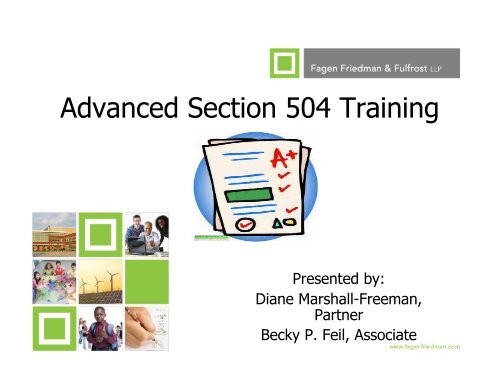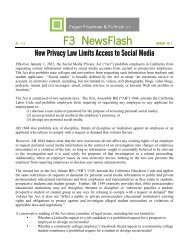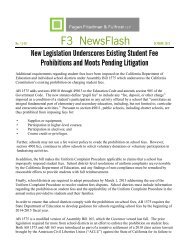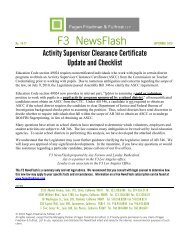Advanced Section 504 Training - Fagen Friedman & Fulfrost
Advanced Section 504 Training - Fagen Friedman & Fulfrost
Advanced Section 504 Training - Fagen Friedman & Fulfrost
Create successful ePaper yourself
Turn your PDF publications into a flip-book with our unique Google optimized e-Paper software.
<strong>Advanced</strong> <strong>Section</strong> <strong>504</strong> <strong>Training</strong><br />
Presented by:<br />
Diane Marshall-Freeman,<br />
Partner<br />
Becky P. Feil, Associate<br />
1
<strong>Advanced</strong> <strong>Section</strong> <strong>504</strong><br />
Brief Overview of <strong>Section</strong> <strong>504</strong><br />
<strong>Advanced</strong> <strong>Training</strong> Scenarios<br />
Q & A<br />
2
Overview of <strong>Section</strong> <strong>504</strong><br />
<strong>Section</strong> <strong>504</strong> of the Rehabilitation Act of 1973<br />
states<br />
“No otherwise qualified individual with a<br />
disability . . ., shall, solely by reason of her or<br />
his disability, be excluded from the participation<br />
in, be denied the benefits of, or be subjected to<br />
discrimination under any program or activity<br />
receiving Federal financial assistance . . . .”<br />
3
Overview of <strong>Section</strong> <strong>504</strong><br />
Congress’ directive to schools to eliminate<br />
disability-based discrimination from all<br />
aspects of school operations<br />
Requires schools to provide eligible disabled<br />
students with equal access (both physical<br />
and academic) to services, programs, and<br />
activities<br />
4
Overview of <strong>Section</strong> <strong>504</strong><br />
<strong>Section</strong> <strong>504</strong> is a civil<br />
rights law not a<br />
special education law<br />
5
Overview of <strong>Section</strong> <strong>504</strong><br />
The Individuals with Disabilities<br />
Improvement Act of 2004 (IDEA) is a special<br />
education law<br />
Both the IDEA and <strong>Section</strong> <strong>504</strong> require<br />
school districts to provide eligible students<br />
with disabilities a free appropriate public<br />
education (FAPE)<br />
6
Review of <strong>Section</strong> <strong>504</strong><br />
Two Main Purposes of <strong>Section</strong> <strong>504</strong><br />
Non-Discrimination Duty<br />
Duty to Provide a FAPE<br />
7
Remember - Non-Discrimination Duty<br />
Protects students from discrimination<br />
Assures access to educational services and the<br />
learning process that is equal to that given to<br />
students who do not have disabilities<br />
Who is covered? All students are protected from<br />
discrimination under <strong>Section</strong> <strong>504</strong> who:<br />
have a physical or mental impairment which limits<br />
substantially one or more major life activities,<br />
have a record of such an impairment, or<br />
are regarded as having such an impairment<br />
8
Remember - Non-Discrimination Duty<br />
Local education agencies (LEAs) are<br />
prohibited from<br />
Excluding a student with a disability from<br />
participation in any district program or activity<br />
Denying a student with a disability the benefits<br />
of any district program or activity and<br />
Subjecting a student with a disability to<br />
discrimination solely by reason of her disability<br />
9
Non-Discrimination Duty<br />
Example: Non-educational Programs<br />
Includes programs such as before-and-after<br />
school day care and summer recreation<br />
programs, extracurricular and non-academic<br />
activities<br />
Issue is meaningful access and equal<br />
opportunity, as opposed to FAPE<br />
10
Non-Discrimination Duty<br />
Example: Non-educational Programs<br />
LEAs must provide access to students in noneducational<br />
programs (e.g., medical services, aide<br />
support, modifications to district policies, practices<br />
or procedures)<br />
Unless it will cause the LEA an undue burden or<br />
fundamentally alter the nature of the LEA’s program<br />
LEAs cannot mandate or condition student<br />
participation in a program on parents providing<br />
services<br />
11
Duty to Provide a FAPE<br />
Applies to students who actually have a<br />
physical or mental impairment that<br />
substantially limits one or more major life<br />
activities, and<br />
Attend public elementary and secondary<br />
education programs, or who are entitled to a<br />
FAPE under the IDEA and state law<br />
12
Duty to Provide a FAPE<br />
<strong>Section</strong> <strong>504</strong> FAPE<br />
The provision of regular or special education and<br />
related aids and services that are designed to<br />
meet the needs of individuals with disabilities as<br />
adequately as the needs of individuals without<br />
disabilities are met.<br />
The focus is not whether the program meets a<br />
student’s individualized needs (IDEA)<br />
It’s whether the LEA can meet the student’s needs as<br />
adequately as the needs of student’s without<br />
disabilities<br />
13
<strong>Section</strong> <strong>504</strong> Steps<br />
14
<strong>Section</strong> <strong>504</strong> Steps: Step 1<br />
15
Step 1: Child Find<br />
1. LEA must find the<br />
disabled<br />
2. Do not wait for a<br />
parent to request an<br />
evaluation<br />
3. When an evaluation is<br />
requested, respond<br />
and provide<br />
procedural safeguards<br />
16
Step 1: Child Find<br />
Remember<br />
Child find is an LEA obligation<br />
Must respond to a parent request<br />
Procedural Safeguards<br />
SSTs often “find” students for purpose of<br />
evaluation<br />
FIND = EVALUATION (not eligibility)<br />
17
Step 1: Child Find<br />
Finding Requirement<br />
LEA must conduct an evaluation of any person<br />
who, because of handicap, needs, or is believed<br />
to need, special education or related services<br />
before taking any action with respect to the<br />
initial placement of the person in regular or<br />
special education<br />
18
Step 1: Child Find<br />
Finding Requirement<br />
A recipient that operates a public elementary or<br />
secondary education program or activity shall<br />
annually<br />
a. Undertake to identify and locate every qualified<br />
handicapped person residing in the recipient's<br />
jurisdiction who is not receiving a public education,<br />
and<br />
b. Take appropriate steps to notify handicapped<br />
persons and their parents or guardians of the<br />
recipient's duty under this subpart<br />
19
Step 2: Evaluation<br />
20
Step 2: Evaluation<br />
LEAs must promptly evaluate when there is<br />
a reason to suspect the student might<br />
qualify for <strong>Section</strong> <strong>504</strong><br />
When you find, you evaluate within reasonable<br />
time of the “finding”<br />
Evaluation gathers all relevant data for<br />
eligibility determination<br />
Evaluation must address all suspected areas<br />
of disability<br />
21
Appropriate Evaluation<br />
Tests and other evaluation materials must<br />
include those tailored to evaluate the specific<br />
areas of educational need and not merely<br />
those designed to provide a single intelligence<br />
quotient<br />
Tests and other evaluation materials must be<br />
validated for the specific purpose for which<br />
they are used, and<br />
Appropriately administered by trained<br />
personnel<br />
22
Step 2: Evaluation<br />
Gathering the Information for Evaluation<br />
Utilize a variety of sources so that the possibility<br />
of error is minimized<br />
Document the information collected and all<br />
significant factors related to the student's<br />
learning process must be considered<br />
U.S. Department of Education, Frequently Asked Questions<br />
About <strong>Section</strong> <strong>504</strong> and the Education of Students with Disabilities<br />
23
Step 3: Eligibility Determinations<br />
24
Step 3: Eligibility Determinations<br />
In January 2009, revisions to the ADA<br />
Amendments Act (ADAA) of 2008 went into<br />
effect and changed how we determine<br />
eligibility under <strong>Section</strong> <strong>504</strong><br />
25
Step 3: Eligibility Determinations<br />
The amended ADA states<br />
“The definition of disability shall be construed in<br />
favor of broad coverage of individuals . . . to the<br />
maximum extent permitted by the terms of this<br />
Act.”<br />
(42 U.S.C. 12102(4)(B))<br />
26
Step 3: Eligibility Determinations<br />
“It is the intent of Congress that the primary object<br />
of attention . . . should be whether entities<br />
covered under the ADA have complied with their<br />
obligations, and . . . . The question of whether an<br />
individual’s impairment is a disability under the<br />
ADA should not demand extensive analysis.”<br />
(122 Stat. 3553 § (2)(b)(5))<br />
27
Step 3: Eligibility Determinations<br />
The team analyzes if the student has<br />
Impairment that<br />
Substantially limits<br />
One or more major life activities<br />
28
Step 3: Eligibility Determinations<br />
Therefore, to be entitled to a <strong>504</strong> FAPE, i.e.<br />
development of a <strong>Section</strong> <strong>504</strong> Plan, a<br />
student must have a<br />
Physical or mental impairment that substantially<br />
limits one or more major life activities<br />
<strong>Section</strong> <strong>504</strong> team must meet to review the<br />
evaluation results to make an eligibility<br />
determination<br />
29
Step 3: Eligibility Determinations<br />
ADA Amendments 2008<br />
Impairments include those that are episodic<br />
or in remission<br />
Cancer in remission<br />
“Substantially limits” to be broadly construed<br />
Do not consider mitigation measures when<br />
determining whether an impairment<br />
substantially limits a major life activity<br />
30
Step 3: Eligibility Determinations<br />
Team Reviews<br />
All existing data<br />
LEA generated<br />
Parent generated<br />
Take in and consider parent input<br />
Get releases of information to speak with<br />
persons having important information<br />
(i.e., the doctor who wrote a note)<br />
31
Step 3: Eligibility Determinations<br />
The Team<br />
Persons, including persons knowledgeable about<br />
the child, the meaning of the evaluation data,<br />
and the placement options<br />
(34 CFR <strong>Section</strong> 104.35(c)(3))<br />
Parents<br />
Student, if appropriate<br />
32
Step 3: Eligibility Determinations<br />
Physical or Mental Impairment<br />
Any physiological disorder or condition, cosmetic<br />
disfigurement, or anatomical loss; or any mental<br />
or psychological disorder such as mental<br />
retardation, organic brain syndrome, emotional<br />
or mental illness, and specific learning<br />
disabilities<br />
33
Step 3: Eligibility Determinations<br />
Major Life Activity<br />
Learning is one of many major life activities<br />
Think about more than learning as a major life<br />
activity<br />
34
Step 3: Eligibility Determinations<br />
Make your eligibility determination<br />
Eligible<br />
Ineligible<br />
35
Step 3: Eligibility Determinations<br />
If student is ineligible, give parent<br />
Complete <strong>Section</strong> <strong>504</strong> Service Plan<br />
Document that the student is not eligible<br />
Provide parent with written documentation<br />
regarding eligibility determination<br />
<strong>Section</strong> <strong>504</strong> Service Plan<br />
<strong>Section</strong> <strong>504</strong> Prior Written Notice<br />
Notice of parent rights under <strong>Section</strong> <strong>504</strong> –<br />
Procedural Safeguards<br />
Opportunity to review records<br />
Impartial hearing with opportunity for parent to<br />
participate and be represented by counsel<br />
36
Step 3: Eligibility Determinations<br />
If student is eligible,<br />
Develop <strong>Section</strong> <strong>504</strong> Service Plan<br />
Document the student is eligible<br />
Include in the <strong>Section</strong> <strong>504</strong> Service Plan<br />
the student’s placement in LRE,<br />
including<br />
Specific accommodations or services<br />
Schedule for review<br />
Notice that review may occur<br />
sooner upon request by parent/staff<br />
37
Step 3: Eligibility Determinations<br />
Provide parent with written documentation<br />
regarding eligibility determination<br />
<strong>Section</strong> <strong>504</strong> Service Plan<br />
<strong>Section</strong> <strong>504</strong> Prior Written Notice<br />
Provide parent with notice of parent rights under<br />
<strong>Section</strong> <strong>504</strong> – Procedural Safeguards<br />
38
Step 4: Placement<br />
39
Step 4: Placement<br />
What is FAPE under <strong>Section</strong> <strong>504</strong>?<br />
FAPE is not limited to accommodations<br />
(San Dieguito Union Sch. Dist. (OCR 2009))<br />
The provision of regular or special education and<br />
related aids and services<br />
Designed to meet the needs of individuals with<br />
disabilities as adequately as the needs of<br />
individuals without disabilities are met<br />
40
Step 4: Placement<br />
What is FAPE under <strong>Section</strong> <strong>504</strong>?<br />
<strong>Section</strong> <strong>504</strong> emphasizes “design” of<br />
educational plans to assure needs of nondisabled<br />
being adequately met and to<br />
provide “meaningful access”<br />
Leveling the Playing Field<br />
Contrast with IDEA FAPE which focuses on<br />
“meaningful benefit”<br />
41
Step 4: Placement<br />
Remember, qualifying students<br />
Have a right to placement in the least restrictive<br />
environment (34 CFR § 104.34)<br />
Must be served in the same setting as<br />
nondisabled students “to the maximum extent<br />
appropriate to the needs of the handicapped<br />
person”<br />
Cannot be given less than their nondisabled<br />
counter parts<br />
42
Step 5: Implementation<br />
43
Step 5: Implementation<br />
<strong>Section</strong> <strong>504</strong> plan documents FAPE<br />
The plan must be implemented in order for the<br />
student to receive a FAPE under <strong>Section</strong> <strong>504</strong><br />
Make sure all who need to know have and<br />
implement a student’s <strong>504</strong> plan<br />
Teachers, principal, other administrators<br />
responsible for discipline, service providers, etc.<br />
44
Step 5: Implementation<br />
Periodic review<br />
Record keeping<br />
Assign responsibility for plan compliance<br />
45
Step 5: Implementation<br />
<strong>Section</strong> <strong>504</strong> Service Plan must be implemented<br />
with fidelity<br />
Failure to implement the plan can land the LEA in<br />
hot water with OCR<br />
If a teacher intentionally does not implement a<br />
<strong>Section</strong> <strong>504</strong> Service Plan or IEP, then money<br />
damages could be awarded under <strong>Section</strong> <strong>504</strong><br />
The standard parents must prove is the LEA intentionally<br />
or with deliberate indifference failed to provide<br />
meaningful access or reasonable accommodation to the<br />
student<br />
46
Recap: <strong>Section</strong> <strong>504</strong> Steps<br />
Step 1 - Child Find<br />
Step 2 - Evaluation<br />
Step 3 - Eligibility<br />
Step 4 - Placement<br />
Step 5 - Implementation<br />
47
Important Considerations<br />
48
Important Considerations:<br />
Reconsidering Eligibility<br />
<strong>504</strong> Team who found<br />
student ineligible in<br />
2008 was to<br />
reconsider under<br />
expanded eligibility<br />
under the amended<br />
ADA.<br />
Zachary M. v. Evanston Township High Sch. Dist. (N.D. Ill. 2009) 53 IDELR 21.<br />
49
Important Considerations:<br />
Reconsidering Eligibility<br />
In 2008, the district found the Zachary<br />
ineligible for a <strong>504</strong> Plan, explaining that his<br />
ADHD did not impair his learning.<br />
A due process hearing officer agreed.<br />
In 2009, the parents appealed by filing a<br />
lawsuit in federal court.<br />
Zachary M. v. Evanston Township High Sch. Dist. (N.D. Ill. 2009) 53 IDELR 21.<br />
50
Important Considerations:<br />
Reconsidering Eligibility<br />
The court noted that the ADA Amendment Act<br />
expanded eligibility as of January 1, 2009, to<br />
include students whose impairments substantially<br />
limit their reading, thinking, or concentration.<br />
The district claimed it planned to reconsider the<br />
student's eligibility in light of the amended ADA,<br />
however, the court rejected the district's request to<br />
dismiss the parents' lawsuit because the meeting<br />
to reconsider Zachary's <strong>504</strong> eligibility had not yet<br />
occurred.<br />
Zachary M. v. Evanston Township High Sch. Dist. (N.D. Ill. 2009) 53 IDELR 21.<br />
51
Important Considerations: Discipline<br />
Manifestation Determination<br />
Must be conducted before a disciplinary change<br />
of placement is contemplated<br />
<strong>Section</strong> <strong>504</strong> does not provide the standard to<br />
consider<br />
IDEA standard<br />
1. Was the conduct in question caused by, or was<br />
there a direct and substantial relationship to the<br />
child’s disability, or<br />
2. Was the conduct in question the direct result of the<br />
district’s failure to implement the <strong>Section</strong> <strong>504</strong> plan<br />
52
Important Considerations: Discipline<br />
Manifestation Determination<br />
A student may not be disciplined if the conduct<br />
was caused by his/her disability<br />
53
Important Considerations:<br />
Parent Complaints<br />
Complaint Venues<br />
Uniform Complaint Procedure (“UCP”)<br />
Parent files complaint<br />
LEA investigates<br />
Appeal to CDE<br />
Office of Civil Rights (“OCR”)<br />
Parent files complaint<br />
OCR investigates<br />
OCR issues a decision<br />
54
Hypothetical 1-Accelerated Programs<br />
Adam, a high school student with ADD, participates<br />
in the general education program with<br />
accommodations and modifications through a<br />
<strong>Section</strong> <strong>504</strong> plan. Adam meets with his counselor<br />
and requests to take advanced placement classes<br />
the following year. The counselor tells Adam that<br />
he can only take advanced placement classes if he<br />
“gives up” the accommodations and modifications<br />
in his <strong>Section</strong> <strong>504</strong> plan. Result?<br />
55
Hypothetical 1-Accelerated Programs<br />
CANNOT deny access to accelerated<br />
programs based on disability<br />
CAN have appropriate eligibility<br />
requirements<br />
CANNOT require forfeiting special education<br />
or services or aids<br />
28 C.F.R. 35.130<br />
Letter to Anonymous/Dear Colleague Letter (OCR 2007)<br />
108 LRP 16376<br />
Southfield (MI) Public Schools (OCR 2012) 112 LRP 28804<br />
56
Hypothetical 2-Report Cards<br />
Susan is a middle school student with a learning<br />
disability who participates in the general education<br />
classroom. Her <strong>Section</strong> <strong>504</strong> plan includes<br />
accommodations and modifications, including<br />
reducing the amount of math problems that Susan<br />
is required to do for homework and allowing Susan<br />
to use a calculator on tests. Susan’s math teacher<br />
refuses to provide grading information for Susan<br />
since “she did not do the same things as everyone<br />
else.” Result?<br />
57
Hypothetical 2<br />
Report Cards<br />
Must provide report cards or some type of<br />
progress update<br />
Must be as informative and effective as report<br />
cards provided to nondisabled students<br />
Any method or format is acceptable<br />
Dear Colleague Letter (OCR 2008)<br />
Orcas Island (WA) Sch. Dist. No. 137 (OCR 1999)<br />
31 IDELR 12<br />
58
Hypothetical 2a-Report Cards<br />
When told she has to provide grading information,<br />
Susan’s math teacher wants to know whether she<br />
can include language on the report card to show<br />
that Susan received accommodations in her<br />
instruction. Result?<br />
59
Hypothetical 2a<br />
Report Cards<br />
Yes, notations to show modifications to<br />
curriculum<br />
Yes, notations to show accommodations<br />
received<br />
Caution, different standards for transcripts<br />
60
Hypothetical 3-Transportation<br />
Francis is an elementary school student with cerebral<br />
palsy who participates in the general education<br />
classroom with accommodations and modifications.<br />
Francis is transported by the special education school<br />
bus every day. Francis uses a wheelchair and it takes<br />
the bus extra time to use the wheelchair technology to<br />
load Francis on and off the bus. Plus the special<br />
education bus picks up students on a different schedule<br />
to avoid traffic. Because of this, Francis arrives 25<br />
minutes late and leaves class 15 minutes early every<br />
day. Francis’ <strong>Section</strong> <strong>504</strong> plan does not call for a<br />
shortened day. Result?<br />
61
Hypothetical 3-Transportation<br />
Cannot shorten instructional day due to<br />
transportation issues<br />
Can shorten instructional day based on individual<br />
determination<br />
34 C.F.R. 104.33<br />
Lincoln County (NC) School District (1991 OCR) 17 IDELR<br />
1052<br />
Duchesne County (UT) School District (1990 OCR) 17<br />
IDELR 240<br />
Blount County (TN) School District (2004 OCR) 42 IDELR 65<br />
62
Hypothetical 4-Field Trips<br />
Kelly is a kindergarten student with diabetes who<br />
requires insulin shots and blood testing daily. Kelly<br />
is not old enough to give herself her own insulin<br />
shots. Kelly’s science class is taking an overnight<br />
field trip to San Francisco. Kelly’s teachers are<br />
concerned that Kelly’s diabetes is going to interfere<br />
with the trip. Kelly’s teacher tells Kelly’s mother<br />
that the long duration of the trip, combined with<br />
the fast pace of activities will prevent any staff<br />
member from being able to give Kelly her insulin<br />
shots and test her blood. Kelly’s teacher states<br />
that the potential safety concern means that Kelly<br />
cannot go on the trip. Result?<br />
63
Hypothetical 4-Field Trip<br />
Must provide the same opportunity for<br />
participation in nonacademic and extracurricular<br />
activities<br />
Cannot exclude student based on disability alone<br />
IEP or <strong>Section</strong> <strong>504</strong> team should make<br />
determination on limitations on field trips<br />
Lewis Palmer (CO) School District #38 (OCR 2006) 47 IDELR<br />
111<br />
Nyack (NY) Unified School District (OCR 2004) 43 IDELR 169<br />
64
Hypothetical 4a-Field Trips<br />
Kelly’s teacher backs down and says that Kelly can<br />
attend the overnight field trip if one of her parents<br />
attends as well. Result?<br />
65
Hypothetical 4a-Field Trips<br />
No, cannot condition participation in field<br />
trip on parent attendance<br />
Unless district policy requiring parent<br />
attendance applies to all students, disabled<br />
and nondisabled<br />
Calcasieu Parish (LA) School Board (OCR 2005) 44 IDELR<br />
49<br />
Marion County (FL) School District (OCR 1998) 28 IDELR<br />
1091<br />
66
Hypothetical 5-Allergies<br />
Peter is a high school student who suffers from<br />
environmental allergies. He is allergic to all<br />
commercially used cleaning agents. Because his<br />
classes are all in different classrooms, there is no<br />
way for the school to be sure that he will not come<br />
into contact with the cleaning agents used by the<br />
janitorial staff. Peter’s parents demand that the<br />
school stop using all commercial cleaning products<br />
so that Peter can safely attend school. Result?<br />
67
Hypothetical 5-Allergies<br />
District must work to accommodate the<br />
disabilities of a student with environmental<br />
allergies<br />
South Windsor (CT) Public School (OCR 2002) 37 IDELR<br />
133<br />
Walpole Public Schools (SEA MA 1997) 26 IDELR 976<br />
68
Hypothetical 6-ADD and ADHD<br />
Shanea and David are all students at ABC<br />
Elementary School who have been diagnosed with<br />
ADD or ADHD<br />
Shanea is an A and B student with no discipline<br />
problems. The school is aware that she has been<br />
diagnosed with ADD and receives medication.<br />
Should the District conduct an evaluation of<br />
Shanea?<br />
69
Hypothetical 6-ADD and ADHD<br />
David often earns Cs, Ds, and Fs. He has spent a<br />
lot of time in the principal’s office. David has been<br />
referred to a student study team. David’s teacher<br />
has suggested to his parents that he be tested for<br />
ADHD due to his distractibility. Should the District<br />
conduct an evaluation of David?<br />
70
Hypothetical 6-ADD<br />
and ADHD<br />
If the District is aware that a student has ADD or<br />
ADHD or exhibits behaviors that make this a<br />
plausible explanation, the District should consider<br />
evaluating the student<br />
34 CFR 104.35<br />
Oak Harbor (WA) School District No. 201 (OCR 2004) 45<br />
IDELR 228<br />
Triton (MA) Regional Union 68 School District (OCR 1994)<br />
21 IDELR 1077<br />
Marysville (WA) School Dist. No. 25 (OCR 1996) 25 IDELR<br />
992<br />
71
Hypothetical 7-Comparable Facility<br />
ABC Middle School has recently experienced a lot<br />
of growth in student numbers. As a result, they<br />
purchase 3 portable buildings that are placed on<br />
the edge of the playing field. At the beginning of<br />
the school year, one of these portables houses a<br />
7th grade math class. The other two portables<br />
house special day classes of special education<br />
students. Is it okay to house the special education<br />
class in a portable?<br />
72
Hypothetical 7-Comparable Facility<br />
Must have a valid purpose for the use of<br />
portables<br />
Must be a comparable facility to that<br />
provided to nondisabled students<br />
34 CFR 104.34<br />
Red Oak (IA) Community School District (OCR 1991) 18<br />
IDELR 224<br />
Sumner County (TN) School District (OCR 1991) 17 IDELR<br />
1038<br />
73
Questions and Answers<br />
74
Thank you for coming!<br />
75

















